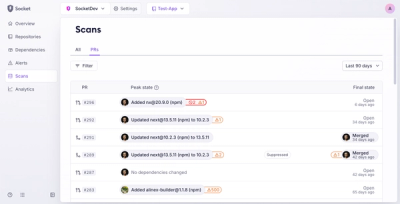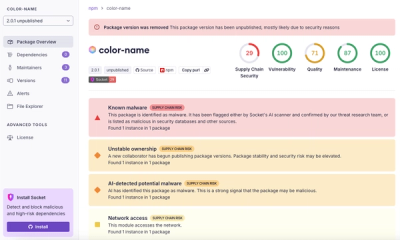
Product
Introducing Pull Request Stories to Help Security Teams Track Supply Chain Risks
Socket’s new Pull Request Stories give security teams clear visibility into dependency risks and outcomes across scanned pull requests.
A fast XML parser and Object marshaller as a Ruby gem.
gem install ox
Documentation: http://www.ohler.com/ox
GitHub repo: https://github.com/ohler55/ox
RubyGems repo: https://rubygems.org/gems/ox
Get supported Ox with a Tidelift Subscription. Security updates are supported.
Ruby XML Gem Comparison for a performance comparison between Ox, Nokogiri, and LibXML.
Fast Ruby XML Serialization to see how Ox can be used as a faster replacement for Marshal.
Fast JSON parser and marshaller on RubyGems: https://rubygems.org/gems/oj
Fast JSON parser and marshaller on GitHub: https://github.com/ohler55/oj
See CHANGELOG.md
Optimized XML (Ox), as the name implies was written to provide speed optimized XML and now HTML handling. It was designed to be an alternative to Nokogiri and other Ruby XML parsers in generic XML parsing and as an alternative to Marshal for Object serialization.
Unlike some other Ruby XML parsers, Ox is self contained. Ox uses nothing other than standard C libraries so version issues with libXml are not an issue.
Marshal uses a binary format for serializing Objects. That binary format changes with releases making Marshal dumped Object incompatible between some versions. The use of a binary format make debugging message streams or file contents next to impossible unless the same version of Ruby and only Ruby is used for inspecting the serialize Object. Ox on the other hand uses human readable XML. Ox also includes options that allow strict, tolerant, or a mode that automatically defines missing classes.
It is possible to write an XML serialization gem with Nokogiri or other XML parsers but writing such a package in Ruby results in a module significantly slower than Marshal. This is what triggered the start of Ox development.
Ox handles XML documents in three ways. It is a generic XML parser and writer, a fast Object / XML marshaller, and a stream SAX parser. Ox was written for speed as a replacement for Nokogiri, Ruby LibXML, and for Marshal.
As an XML parser it is 2 or more times faster than Nokogiri and as a generic XML writer it is as much as 20 times faster than Nokogiri. Of course different files may result in slightly different times.
As an Object serializer Ox is up to 6 times faster than the standard Ruby Marshal.dump() and up to 3 times faster than Marshal.load().
The SAX like stream parser is 40 times faster than Nokogiri and more than 13 times faster than LibXML when validating a file with minimal Ruby callbacks. Unlike Nokogiri and LibXML, Ox can be tuned to use only the SAX callbacks that are of interest to the caller. (See the perf_sax.rb file for an example.)
Ox is compatible with Ruby 2.3, 2.4, 2.5, 2.6, 2.7, 3.0.
require 'ox'
class Sample
attr_accessor :a, :b, :c
def initialize(a, b, c)
@a = a
@b = b
@c = c
end
end
# Create Object
obj = Sample.new(1, "bee", ['x', :y, 7.0])
# Now dump the Object to an XML String.
xml = Ox.dump(obj)
# Convert the object back into a Sample Object.
obj2 = Ox.parse_obj(xml)
require 'ox'
doc = Ox::Document.new
instruct = Ox::Instruct.new(:xml)
instruct[:version] = '1.0'
instruct[:encoding] = 'UTF-8'
instruct[:standalone] = 'yes'
doc << instruct
top = Ox::Element.new('top')
top[:name] = 'sample'
doc << top
mid = Ox::Element.new('middle')
mid[:name] = 'second'
top << mid
bot = Ox::Element.new('bottom')
bot[:name] = 'third'
bot << 'text at bottom'
mid << bot
other_elements = Ox::Element.new('otherElements')
other_elements << Ox::CData.new('<sender>John Smith</sender>')
other_elements << Ox::Comment.new('Director\'s commentary')
# other_elements << Ox::DocType.new('content')
other_elements << Ox::Raw.new('<warning>Be carefull with this! Direct inject into XML!</warning>')
top << other_elements
xml = Ox.dump(doc)
# xml =
# <?xml version="1.0" encoding="UTF-8" standalone="yes"?>
# <top name="sample">
# <middle name="second">
# <bottom name="third">text at bottom</bottom>
# </middle>
# <otherElements>
# <![CDATA[<sender>John Smith</sender>]]>
# <!-- Director's commentary -->
# <warning>Be carefull with this! Direct inject into XML!</warning>
# </otherElements>
# </top>
Ox can be used to parse HTML with a few options changes. HTML is often loose in regard to conformance. For HTML parsing try these options.
Ox.default_options = {
mode: :generic,
effort: :tolerant,
smart: true
}
require 'stringio'
require 'ox'
class Sample < ::Ox::Sax
def start_element(name); puts "start: #{name}"; end
def end_element(name); puts "end: #{name}"; end
def attr(name, value); puts " #{name} => #{value}"; end
def text(value); puts "text #{value}"; end
end
io = StringIO.new(%{
<top name="sample">
<middle name="second">
<bottom name="third"/>
</middle>
</top>
})
handler = Sample.new()
Ox.sax_parse(handler, io)
# outputs
# start: top
# name => sample
# start: middle
# name => second
# start: bottom
# name => third
# end: bottom
# end: middle
# end: top
require 'stringio'
require 'ox'
class Yielder < ::Ox::Sax
def initialize(block); @yield_to = block; end
def start_element(name); @yield_to.call(name); end
end
io = StringIO.new(%{
<top name="sample">
<middle name="second">
<bottom name="third"/>
</middle>
</top>
})
proc = Proc.new { |name| puts name }
handler = Yielder.new(proc)
puts "before parse"
Ox.sax_parse(handler, io)
puts "after parse"
# outputs
# before parse
# top
# middle
# bottom
# after parse
require 'ox'
xml = %{
<top name="sample">
<middle name="second">
<bottom name="third">Rock bottom</bottom>
</middle>
</top>
}
puts Ox.load(xml, mode: :hash)
puts Ox.load(xml, mode: :hash_no_attrs)
#{:top=>[{:name=>"sample"}, {:middle=>[{:name=>"second"}, {:bottom=>[{:name=>"third"}, "Rock bottom"]}]}]}
#{:top=>{:middle=>{:bottom=>"Rock bottom"}}}
The XML format used for Object encoding follows the structure of the Object. Each XML element is encoded so that the XML element name is a type indicator. Attributes of the element provide additional information such as the Class if relevant, the Object attribute name, and Object ID if necessary.
The type indicator map is:
ArrayBase64 - only for legacy loadsClassFloatRegexpHashFixnumBignumRationalSymbolFalseClassObjectRefRangeStringTimeStructComplexRawTrueClassNilClassIf the type is an Object, type 'o' then an attribute named 'c' should be set with the full Class name including the Module names. If the XML element represents an Object then a sub-elements is included for each attribute of the Object. An XML element attribute 'a' is set with a value that is the name of the Ruby Object attribute. In all cases, except for the Exception attribute hack the attribute names begin with an @ character. (Exception are strange in that the attributes of the Exception Class are not named with a @ suffix. A hack since it has to be done in C and can not be done through the interpreter.)
Values are encoded as the text portion of an element or in the sub-elements of the principle. For example, a Fixnum is encoded as:
<i>123</i>
An Array has sub-elements and is encoded similar to this example.
<a>
<i>1</i>
<s>abc</s>
</a>
A Hash is encoded with an even number of elements where the first element is the key and the second is the value. This is repeated for each entry in the Hash. An example is of { 1 => 'one', 2 => 'two' } encoding is:
<h>
<i>1</i>
<s>one</s>
<i>2</i>
<s>two</s>
</h>
Ox supports circular references where attributes of one Object can refer to an Object that refers back to the first Object. When this option is used an Object ID is added to each XML Object element as the value of the 'a' attribute.
This project exists thanks to all the people who contribute. [Contribute].
Become a financial contributor and help us sustain our community. [Contribute]
Support this project with your organization. Your logo will show up here with a link to your website. [Contribute]
FAQs
Unknown package
We found that ox demonstrated a healthy version release cadence and project activity because the last version was released less than a year ago. It has 1 open source maintainer collaborating on the project.
Did you know?

Socket for GitHub automatically highlights issues in each pull request and monitors the health of all your open source dependencies. Discover the contents of your packages and block harmful activity before you install or update your dependencies.

Product
Socket’s new Pull Request Stories give security teams clear visibility into dependency risks and outcomes across scanned pull requests.

Research
/Security News
npm author Qix’s account was compromised, with malicious versions of popular packages like chalk-template, color-convert, and strip-ansi published.

Research
Four npm packages disguised as cryptographic tools steal developer credentials and send them to attacker-controlled Telegram infrastructure.